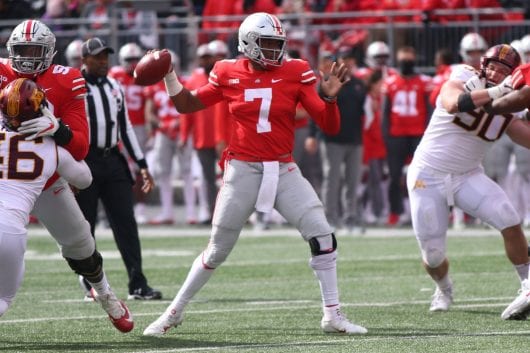
Ohio State redshirt sophomore quarterback Dwayne Haskins (7) throws a pass in the second quarter of the game against Minnesota on Oct. 13. Ohio State won. 30-14. Credit: Casey Cascaldo | Photo Editor
No. 3 Ohio State started the second half of its season with a 30-14 win over Minnesota on Saturday. Even with another dominant performance by redshirt sophomore quarterback Dwayne Haskins in the passing game, the same storylines remain for Ohio State moving forward: the balance of the offense, the inconsistency of the running game and the woes of the secondary.
Here are three other takeaways Ohio State can take into next week when the Buckeyes face Purdue on Saturday.
Haskins struggles in the running game
Ohio State head coach Urban Meyer said in Tuesday’s Big Ten Teleconference Minnesota does a very good job of eliminating big plays through the air, making opposing offenses throw in front of the secondary.
Haskins seemed to beat that secondary pretty frequently. He completed 33-of-44 pass attempts, throwing for 412 yards and three touchdowns. Haskins became the first quarterback in school history to have two 400-yard games in his collegiate career.
Through seven games, this kind of performance has become commonplace for the redshirt sophomore quarterback. However, when Minnesota could contain the passing game, it made Haskins resort to what former Ohio State quarterback J.T. Barrett did very often: run the ball.
On paper, Haskins struggled, rushing for six yards on nine rushes, the most carries he had ever had in a game. Haskins was sacked three times, losing 19 yards on those plays.
Even when he attempted the traditional read or quarterback run, Haskins looked uncomfortable, attempting to find open space and sliding awkwardly at the first sign of contact. The quarterback did have one carry of more than 10 yards, running to the right side for 11 yards in the third quarter.
If anything, Haskins’ performance in the running game shows the importance of sophomore J.K. Dobbins and redshirt junior Mike Weber as the primary running backs in the Ohio State offense.
Campbell, Hill solidify roles in passing game
Redshirt junior wide receiver K.J. Hill had a big game for Ohio State.
Continuing his streak of 27 straight games with a reception, Hill brought in nine catches for a career-high 187 yards, scoring his third and fourth touchdowns of the season.
Redshirt senior Parris Campbell was very productive as well, bringing in eight of 11 targets for 56 yards, with Haskins looking to him as a short target, fast receiver who gets into open space.
Hill and Campbell combined for 21 of 44 of Haskins’ total targets on Saturday, recording 17 of Ohio State’s 33 total catches and 243 of the Buckeyes’ 412 receiving yards, much of that thanks to Hill.
Hill and Campbell have separated themselves as the primary targets in the Ohio State offense. The two receivers are the only two that have recorded more than 40 catches through the first four games and are each averaging over 75 receiving yards per game.
Even though Haskins likes to spread the production around in the passing game, Hill and Campbell have been the primary targets for the veteran receiver room.
Ohio State’s leading tacklers step up
Coming into Saturday’s game, Ohio State had not had a game in which a defender has had over eight tackles in a single game. With the storyline of poor open field tackling because of bad angles taken by both the safeties and linebackers, Ohio State showed improvement against Minnesota.
Junior safety Jordan Fuller led the team with 12 tackles, recording nine solo tackles in Saturday’s 30-14 win over the Golden Gophers. Sophomore linebacker Pete Werner added on 10 tackles, recording 2.5 tackles, including his third sack of the season.


